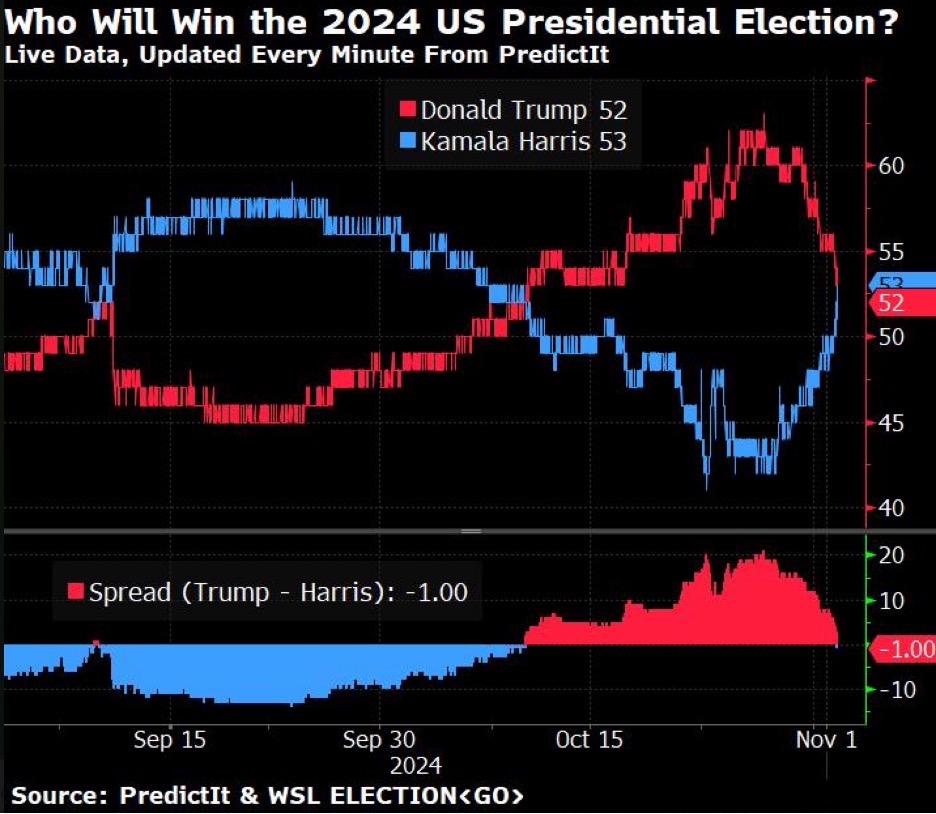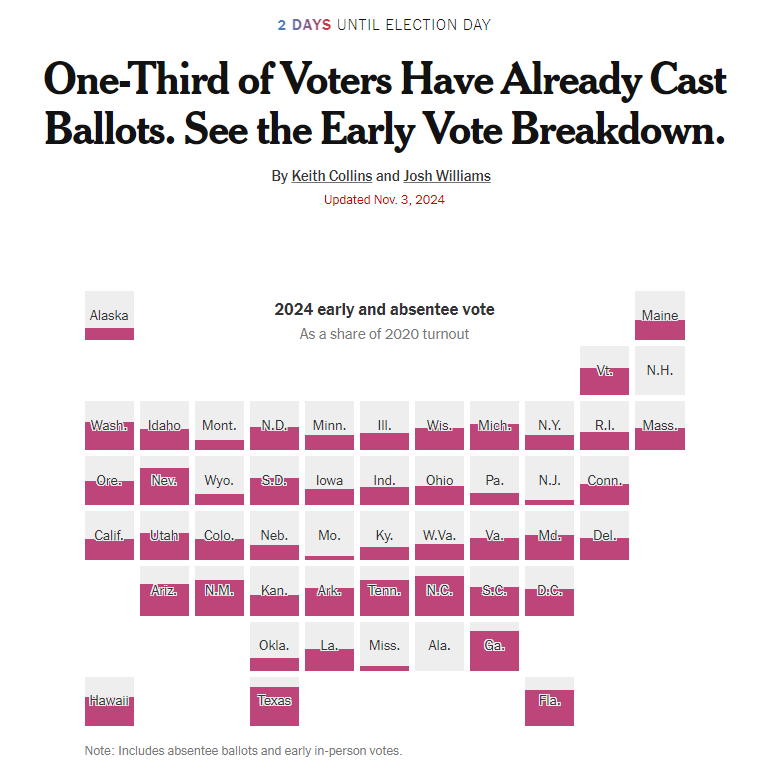Harris's coming back? Analysis based on early voting
The U.S. 2024 election is just around the corner, and early voting results provide important information about the race.
Trump's Winning Percentage Slips, Harris Odds Reverse?
Trump's win percentage has slipped in recent times and his polling support has suffered.Since the end of October, Trump's campaign has been hit with a series of negative events, including controversial comments and alleged betting market manipulation, which has seen his probability of winning the election go from up to down, and is now down to 52%.In contrast, Harris' win probability has also improved to 52 percent, with the two sides once again tied.This shows the tension and uncertainty of the election.
According to data as of Nov. 2, 67 million voters have cast ballots, with 41 percent of them registered Democrats and 40 percent Republicans.In key swing states such as Pennsylvania, Michigan, and Wisconsin, a higher percentage of Democratic voters are registered, especially in Pennsylvania, where Democrats lead by 24 points.This data suggests that Democrats continue to hold an advantage in early voting.
According to the latest data from Nov. 4, PredictIt's results were the first to favor Harris, and other sites Kalshi and Polymarket appear to be starting to follow the same trend.

Uncertainty about the predictive effect of early voting
While early voting data may appear to provide a basis for predicting the final outcome, historical experience suggests that its predictive accuracy is not high.
In the last two elections, the accuracy of early voting in predicting the outcome was 38 percent and 50 percent, respectively.
The percentage of registered Democrats among early voting voters is higher than that of Republicans, but this is of limited use as a reference for the final outcome.In some swing states, particularly Pennsylvania, which is the focus of this poll, UF Election Lab estimates that 56% of early voting voters are Democrats, which is significantly higher than the 33% who are Republicans.
The phenomenon of crossover voting among parties also complicates relying solely on registered party data to determine the race.For example, about 5 percent of registered voters may choose to vote for the other party.
The share of early voting voters in the U.S. is relatively low this year, at only about 33%, and nearly 70% of voters have yet to cast a ballot.The share of early voting voters is also lower in key swing states such as Wisconsin (38%), Michigan (34%) and Georgia (20%).
The Republican disadvantage in early voting has narrowed this year compared to 2020, but the overall race remains tight. in 2020, Democrats led by as much as 6 points, while this year that gap has narrowed to 1 point.This change reflects the volatility of voter sentiment and the unpredictability of the final stretch before the election.
Trump's path to victory: Trump's winning only the "sunbelt" swing states is not enough to reach 270 votes, he needs to win at least one blue-wall state, such as Pennsylvania.
Harris' path to victory: Winning all the blue wall states, especially Pennsylvania, plus the traditional blue states that are almost a lock at this point is just enough to get to 270, which is the more focused path for his campaign at this point.
Unexpected results and their risk analysis
Under normal circumstances, the final results generally come out no later than late in the evening on voting day, but mail-in ballots make up a large portion of the vote and the rules in some swing states that do not allow for early counting suggest that the final results may have to be delayed slightly.
A few important swing states:
Georgia: mail-in ballots are required to be mailed before the polls close; candidates can request a recount if the final margin is less than or equal to 0.5 percent of the total number of votes cast;
North Carolina: mail-in ballots are required to be received by polling day; there is no automatic recount trigger, but candidates can request a recount if the final margin is less than or equal to 0.5 percent of the total number of votes cast or 10,000 votes;
Michigan: mail-in ballots must be received before polls close on Election Day; automatic recounts are triggered if the statewide margin is less than 2,000 votes;
Pennsylvania: mail-in ballots must be received by polling day, early counting is not permitted, so counting can take longer; automatic recounts are triggered if the statewide vote gap is less than or equal to 0.5%;
Wisconsin: mail-in ballots must be received by polling day, early counting is not permitted, and there is no automatic recount trigger, but candidates can request a recount if the final margin is less than or equal to 1%.
Arizona: most voters vote by mail and early counting is allowed, but Election Day ballots need to wait for the polls to close before counting begins, and an automatic recount is triggered if the statewide vote gap is less than or equal to 0.5%;
Nevada: mail-in ballots may take a few days to count, ballots must be postmarked before polling day, mail-in ballots begin counting as soon as they are received, and ballots are allowed to be received until November 9th.
If Trump "unexpectedly" loses the election, it will likely trigger a series of political and economic risks.
The rejection of the election results could lead to a "Capitol Hill Shock 2.0" scenario.
If the election results are disputed and candidates demand a recount, this would further prolong market uncertainty and increase volatility.
Asset Implications
In summary, the early voting results for the US 2024 election show a relative advantage for the Democrats, but uncertainty remains as historical data suggests that early voting has limited predictive power, coupled with a competitive race between the two parties.
The market's reaction to the Trump trade has been evident across multiple asset classes, with U.S. stocks, U.S. bonds, the U.S. dollar, gold, and Bitcoin now reacting more significantly to the expectation of a Trump victory, $.SPX(.SPX)$ $.DJI(.DJI)$ $iShares 20+ Year Treasury Bond ETF(TLT)$ $US10Y(US10Y.BOND)$ $Invesco QQQ(QQQ)$ $SPDR S&P 500 ETF Trust(SPY)$ $Grayscale Bitcoin Mini Trust(BTC)$ $SPDR Gold Shares(GLD)$
The expected reaction to Copper, Crude Oil and China's export chain was relatively minor $Copper - main 2412(HGmain)$ $WTI Crude Oil - main 2412(CLmain)$ $United States Oil Fund LP(USO)$
Trump could continue to trade higher if election results exceed expectations, especially a "Republican victory" (Trump re-elected and in control of both houses).
Conversely, if Harris wins, the market will reverse quickly and all assets associated with the Trump trade could come under pressure.
A full Republican victory would bolster expectations of Trump's policy advances, attracting hesitant investors and driving U.S. stocks, U.S. bonds and Bitcoin higher in the near term potentially.Cyclical assets such as commodities could be at risk of compensatory gains.
A less-than-expected election result, particularly a Harris victory, could lead to an overall market reversal, affecting assets such as the U.S. dollar, U.S. bond rates and gold.On balance, the market needs to pay close attention to the election results and their potential impact on various asset classes.
Disclaimer: Investing carries risk. This is not financial advice. The above content should not be regarded as an offer, recommendation, or solicitation on acquiring or disposing of any financial products, any associated discussions, comments, or posts by author or other users should not be considered as such either. It is solely for general information purpose only, which does not consider your own investment objectives, financial situations or needs. TTM assumes no responsibility or warranty for the accuracy and completeness of the information, investors should do their own research and may seek professional advice before investing.


